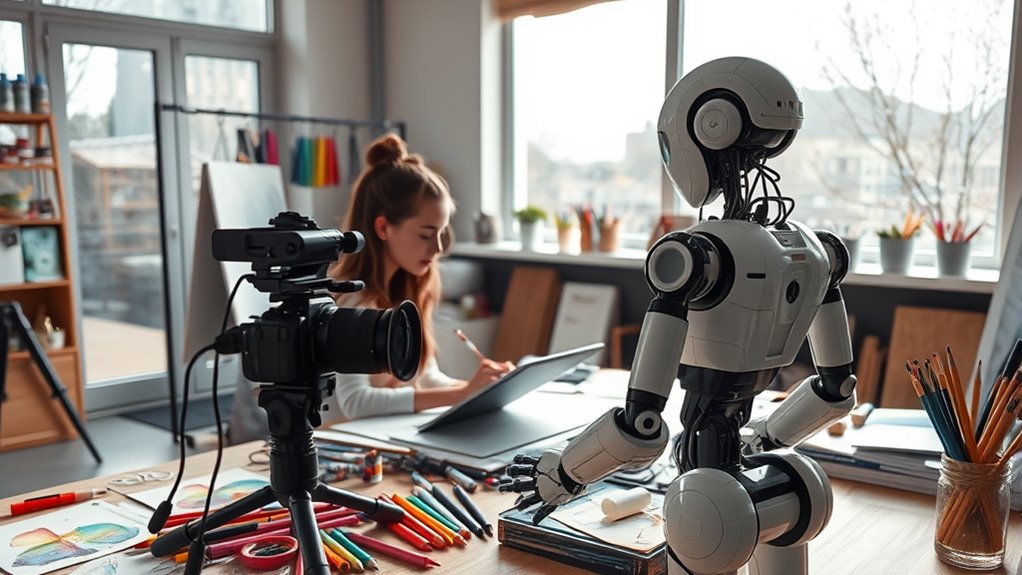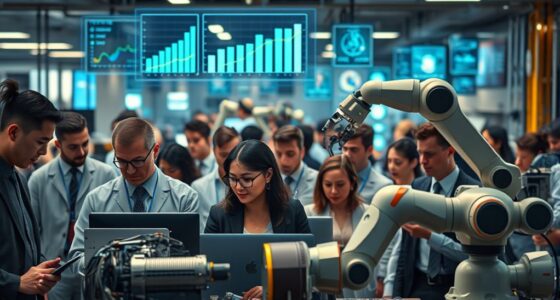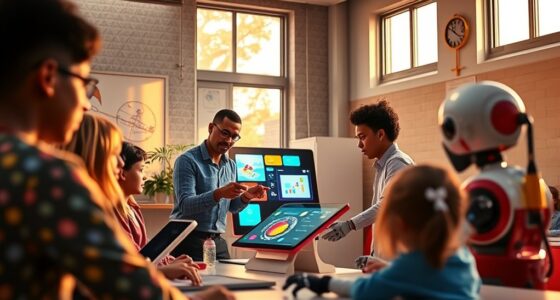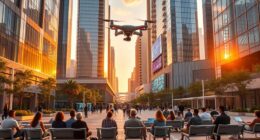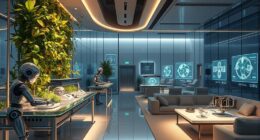AI is rapidly transforming creative industries, automating tasks that once took hours and opening new opportunities for innovation. While some jobs may be displaced, many roles shift toward collaboration, new skills, and higher-level creativity. By embracing AI tools, you can boost your productivity and explore new artistic territories. If you want to understand how to navigate this evolving landscape and stay ahead, there’s much more to discover.
Key Takeaways
- AI automates repetitive tasks but also creates new roles like AI prompt designers and curators, expanding opportunities for creatives.
- The industry’s growth and high adoption rate (83%) indicate AI enhances productivity rather than solely threatening jobs.
- Upskilling in AI tools, ethics, and human-AI collaboration is essential for creatives to remain relevant and competitive.
- Ethical considerations and authenticity concerns highlight the need for responsible AI use, but do not eliminate human creative value.
- AI is a tool that amplifies creativity and innovation, encouraging collaboration rather than replacing the unique human touch.
The Growing Role of AI in Creative Fields
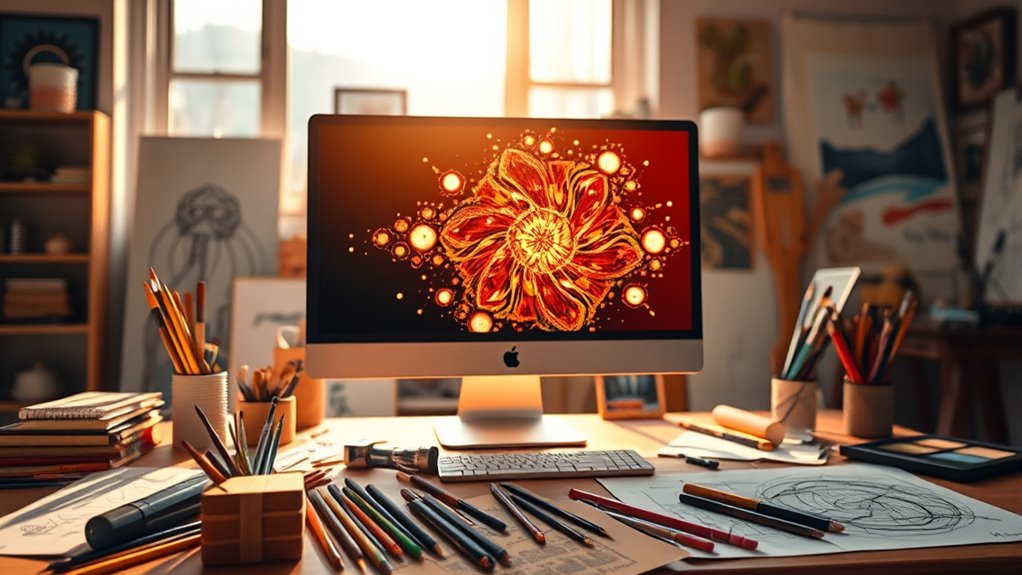
Artificial intelligence is transforming creative fields at an unprecedented pace, reshaping how professionals produce and innovate. The AI video creation market alone hit $614.8 million in 2024, with projections soaring to $2.56 billion by 2032. Overall, the AI-driven creative market grew to $7.60 billion in 2024, up from $5.62 billion the previous year, with an expected compound annual growth rate of nearly 20%. Generative AI in creative industries is forecasted to surge from $1.7 billion in 2022 to $21.6 billion by 2032. Most creative professionals—83%—are integrating AI tools into their workflows, believing AI enhances their capabilities. These advancements foster new business models, improve output quality, and support real-time, personalized content creation, fueling a revolution in how creative work is conceived and executed. The integration of AI-powered creative tools is also contributing to a 40% rise in human-AI musical collaborations, further highlighting its expanding influence across creative domains. Additionally, the integration of creative tools powered by AI is redefining traditional artistic processes and expanding the possibilities for innovation. As AI continues to evolve, it also impacts the visual design industry, opening new avenues for experimentation and creativity. Furthermore, the development of specialized hardware like the Snapdragon 8 Gen 3 chip demonstrates how increased processing power can further enhance AI-driven creative workflows, making tools more accessible and efficient for artists and designers.
Automation and Its Impact on Creative Jobs
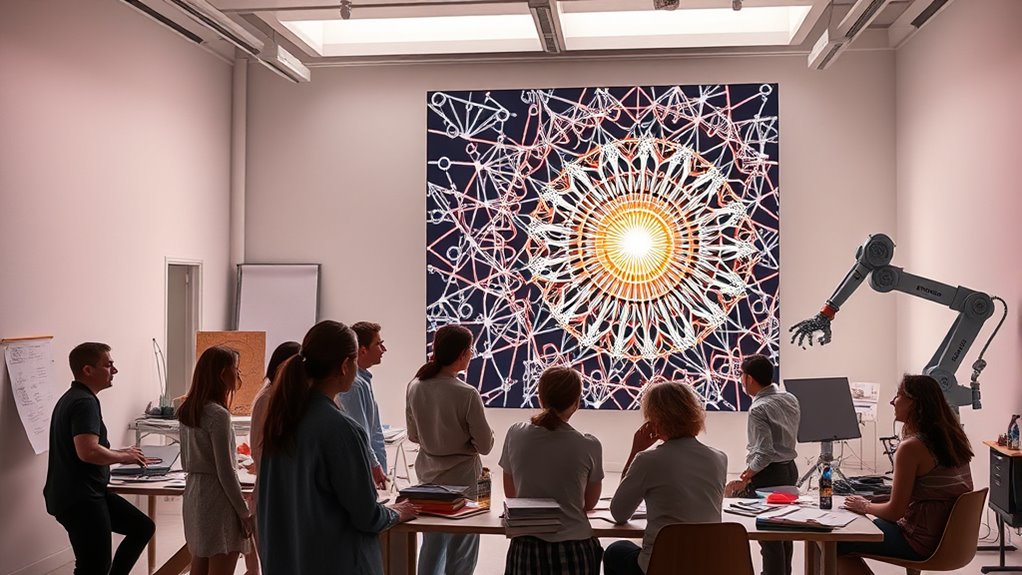
Automation through AI is reshaping creative jobs, with up to 26% of tasks at risk in arts and media. While some roles may be displaced, new opportunities are emerging for professionals to work alongside AI tools. You’ll need to adapt and develop new skills to stay relevant in this evolving landscape. Embracing performance metrics can help creatives better understand how their work resonates with audiences and improve their craft accordingly.
Job Loss Risks
As AI becomes more adept at performing creative tasks, concerns about job losses in creative industries grow. AI can now generate art, music, and other media, automating tasks that were once solely human. This automation risks replacing jobs that rely on repetitive or predictable creative processes, especially in areas like graphic design, illustration, or content production. Industry projections show potential displacement as companies adopt AI for customer service, image recognition, and data analysis, reducing the need for human roles. Meanwhile, as AI takes over certain functions, workers need to upgrade their skills to stay relevant. Creative skill development is essential for professionals aiming to maintain their competitive edge in an evolving industry. AI’s rapid advancement in creative fields also underscores the importance of ongoing skill development for professionals to maintain their competitive edge. While AI can threaten existing jobs, it also prompts a shift in the industry, urging creatives to adapt and find new ways to add value. Additionally, understanding technological integration within creative workflows can help professionals leverage AI tools effectively rather than view them solely as threats. Recognizing the importance of Relationship dynamics can also aid in fostering collaboration between humans and AI, ensuring a balanced creative process. Embracing interdisciplinary collaboration can further enhance creative outputs and open new avenues for innovation. Moreover, advancements in sound healing science demonstrate how integrating new technologies and knowledge can lead to innovative approaches in creative and therapeutic fields.
New Role Emergence
The rise of AI in creative industries is reshaping the roles and skills needed for success. You’re seeing the emergence of new positions like AI prompt designers and AI-generated art curators, which didn’t exist a few years ago. AI tools boost productivity by automating repetitive tasks, allowing you to focus on more complex, creative work. Collaborative platforms enable seamless interaction with AI systems, fostering innovative projects. To thrive, you’ll need to adapt your skills—learning basic AI concepts, understanding ethics, and combining human insight with AI outputs. Automation of routine tasks frees you to explore more innovative ideas, pushing creative boundaries. As AI continues to grow, it’s transforming your profession, opening new opportunities and requiring continuous skill evolution to stay relevant. AI market projected to reach $1.81 trillion by 2030. Additionally, understanding creative workflows and how AI integrates into them will be crucial for staying competitive. Moreover, navigating regulatory and security challenges associated with AI adoption will become increasingly important to ensure ethical and compliant use of these technologies. Staying informed about the latest developments in technological advancements will help you leverage AI effectively in your creative process. Developing a strong grasp of data privacy and security practices will also be essential for responsible AI deployment in creative fields. Staying updated on industry-specific regulations and best practices will also support responsible AI use in creative fields.
Enhancing Creativity and Productivity With AI Tools
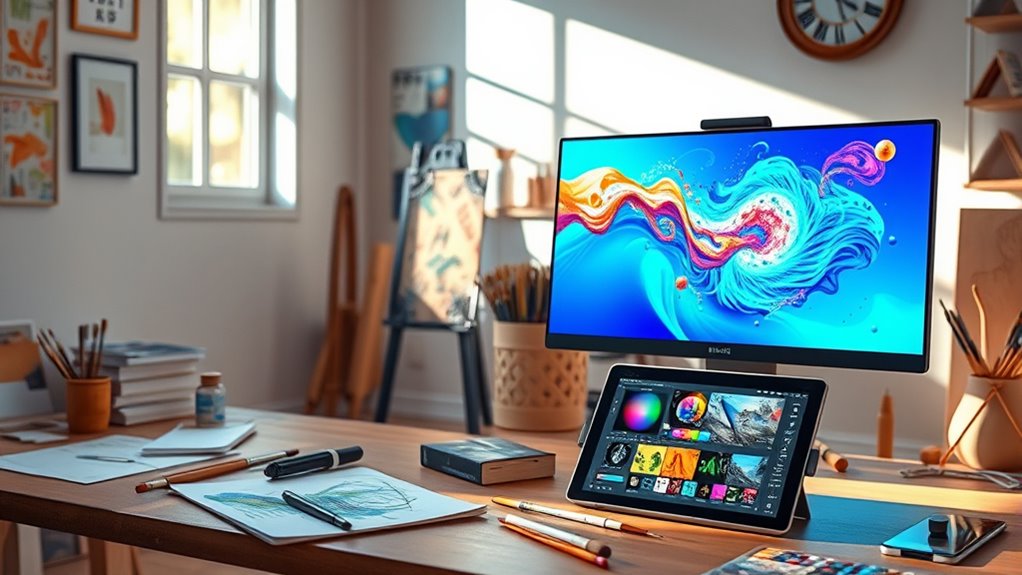
AI tools are transforming the creative landscape by substantially boosting productivity and expanding artistic possibilities. With the global AI in Art and Creativity Market projected to grow at an 18.3% CAGR, more professionals are adopting AI—half of all creative workers now use it. Generative AI can cut creative time by up to 70%, enabling you to focus more on refining ideas. These tools automate repetitive tasks, helping you manage your time more effectively and produce more work in less time. AI also fuels commercial applications like product design and advertising, increasing market demand. The media and entertainment sector is projected to grow at 36.2% CAGR (2020-2025), which indicates that AI-driven innovations are rapidly expanding opportunities for creatives across industries. As AI becomes more accessible and powerful, it enhances your ability to innovate, explore new concepts, and elevate your creative output, making your work more efficient and impactful. Additionally, understanding the market growth and industry trends can help you strategically leverage AI tools to stay competitive and capitalize on emerging opportunities. Recognizing the influence of ethical considerations in AI deployment can also guide responsible and sustainable creative practices. Furthermore, AI security measures ensure that your intellectual property and sensitive data remain protected as you integrate these technologies into your workflow.
Challenges to Authenticity and Human Expression

While AI tools enhance your creative productivity, they also introduce complex questions about authenticity and human expression. The boundaries blur between genuine self-expression and AI-assisted communication, making it harder to discern what’s truly authentic. AI can augment your memory, helping you forge more consistent connections, but biases—often hidden—can threaten artistic integrity. Knowing AI is involved may shift how others perceive your work, often favoring human responses as more authentic. AI’s lack of nuanced understanding and empathy limits its ability to fully capture human emotion and context, essential for authentic expression. While AI democratizes voice and broadens access, it challenges traditional notions of cultural authenticity. 88% of consumers prioritize authenticity when choosing brands, ultimately, questions about authorship, emotional depth, and public perception cast doubt on whether AI-generated art can truly reflect human authenticity.
Emerging Opportunities and New Skill Requirements
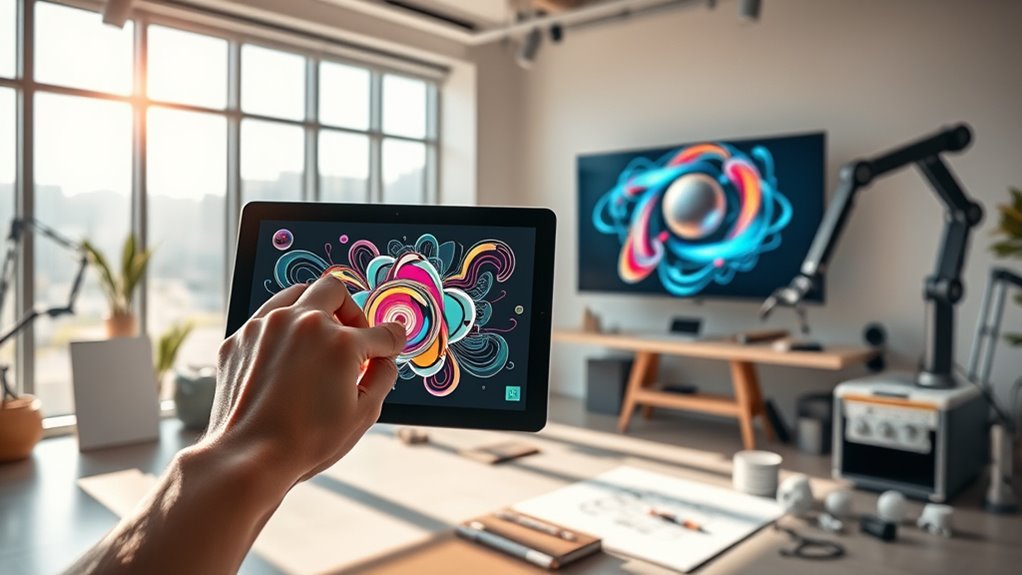
As creative professionals embrace AI tools, you discover new opportunities to expand your artistic horizons and boost productivity. AI integration isn’t just automation; it enhances creativity and pushes your limits. With about 83% of creatives adopting AI, you can now explore new artistic territories and overcome traditional technical barriers. To stay competitive, you need to develop skills in AI-assisted design, prompt engineering, and guiding AI outputs. Hybrid expertise combining traditional art skills with data literacy and AI management becomes essential. As AI automates routine tasks, your role shifts toward strategic decision-making and innovation. New positions like AI technologists emerge, emphasizing collaboration between human creativity and AI capabilities. Embracing these opportunities allows you to innovate faster, experiment more, and produce higher-quality work.
Navigating Market Changes and Future Prospects
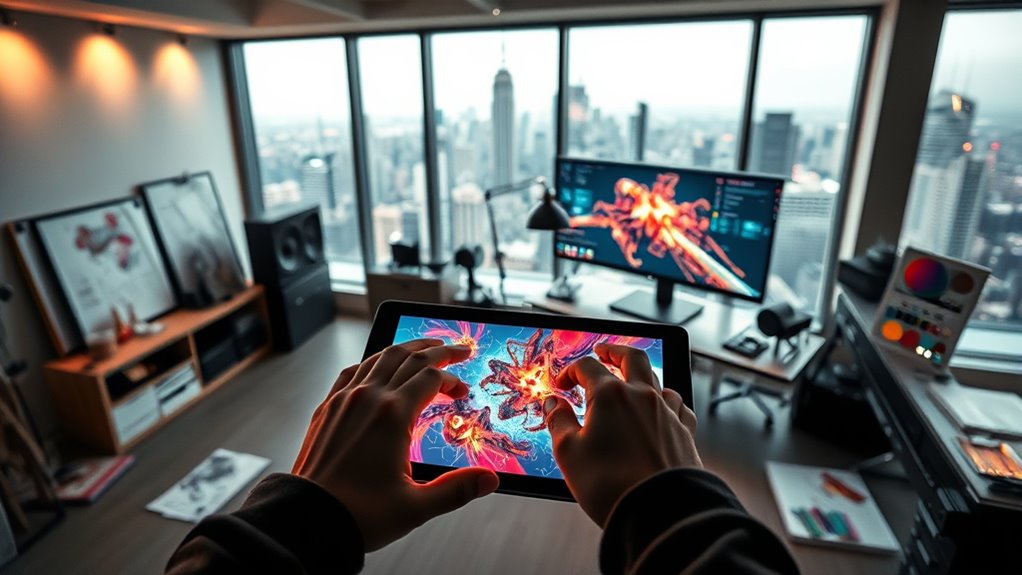
As the creative industry shifts with AI, your job roles will continue to evolve, requiring you to adapt quickly and develop new skills. Staying ahead means embracing industry innovations and learning how to work alongside AI tools effectively. By understanding these changes, you can position yourself for future opportunities and maintain your relevance in a transforming market.
Evolving Job Roles
The rapid integration of AI into creative industries is transforming job roles for designers and artists, requiring professionals to adapt quickly to stay relevant. With 83% of creatives using AI tools, tasks are increasingly augmented or automated, shifting the nature of work. While AI may displace up to 9 million jobs globally, it also opens new opportunities in AI-human collaboration, innovation, and specialized roles. The industry’s focus is shifting toward enhancing productivity and exploring new mediums, prompting a reevaluation of skills and responsibilities. You’ll need to stay flexible, embracing emerging tools and understanding evolving market demands. As AI reshapes workflows, your ability to adapt will determine whether you thrive in this changing landscape or struggle to keep pace.
Skill Adaptation Strategies
Steering the rapidly changing creative landscape requires you to prioritize ongoing upskilling and reskilling. With 83% of professionals already integrating AI tools, staying current means embracing continuous learning through online courses and certifications in platforms like Midjourney, Adobe Firefly, and ChatGPT. Developing hybrid skills—combining technical know-how with creative thinking—boosts your market value. Focus on human-centric abilities such as storytelling, emotional intelligence, and cultural nuance, which AI can’t replicate. Diversify your portfolio to showcase both traditional and AI-augmented work, demonstrating adaptability. Keep an eye on industry trends, learn prompt engineering, and explore niche specializations like experiential design. By proactively updating your skills, you’ll remain competitive and resilient amid automation and evolving market demands.
Industry Innovation Trends
Industry innovation in creative AI is advancing rapidly, transforming how you approach content creation and market engagement. The sector is projected to hit $12.6 billion by 2029, with annual growth over 30%. Generative AI’s market size is expected to grow from $1.7 billion in 2022 to $21.6 billion by 2032. Nearly 90% of notable AI models in 2024 come from industry, highlighting commercial focus and investment. AI art is gaining traction, representing 5% of the art market by 2025, with exhibitions up 25%. Technologies like multimodal AI are enabling seamless content across formats, fostering collaboration and new business models. This landscape is evolving fast, making it essential for creatives to stay informed and adapt to these transformative trends.
| Aspect | Key Point | Future Outlook |
|---|---|---|
| Market Growth | $12.6B by 2029, 30%+ annual growth | Expanding investment and adoption |
| AI Art & Content | 5% of art market by 2025, rising exhibitions | Increased accessibility and engagement |
| Technology Advancements | Multimodal AI, collaboration tools | Enhanced productivity and creativity |
| Market Dynamics | Acceptance rising, new business models | Ongoing innovation and market shifts |
Frequently Asked Questions
How Can Creatives Differentiate Their Work in an Ai-Driven Industry?
To differentiate your work in an AI-driven industry, focus on highlighting your unique vision and personal expression, which AI can’t replicate. Use AI tools as collaborators for inspiration and refinement, but emphasize your deep expertise and storytelling skills. Develop a signature style that sets you apart and engage with your audience through authentic human connection. By blending creativity with technology, you can stand out and add genuine value to your art or design.
What Ethical Considerations Arise From Ai-Generated Art?
Thinking about AI-generated art, you should consider the gentle questions of ethics. Are the data sources respectful of original creators? Does the work preserve authenticity and emotional depth? You need to stay aware of legal issues like copyright infringement and how AI might shift the value of human creativity. Embracing transparency and advocating for fair regulations will help protect your artistic integrity while steering through this evolving landscape.
How Will AI Influence Intellectual Property Rights in Creative Industries?
AI will considerably influence intellectual property rights in creative industries by challenging traditional notions of authorship and ownership. You’ll need to navigate new legal gray areas around AI-generated works, as current laws favor human creators. As AI advances, expect ongoing legal reforms to clarify rights, ensure fair compensation, and address infringement risks. Staying informed and adaptable will be key to protecting your creative rights in this evolving landscape.
What Strategies Can Artists Use to Stay Relevant With Advancing AI Tools?
Your artistic future depends on your ability to adapt faster than AI evolves—imagine a race where staying ahead means the difference between standing out or being left behind. To stay relevant, embrace AI as a creative partner, learn new digital skills, and explore hybrid art forms. Collaborate with AI tools, attend innovative exhibitions, and diversify your services. By doing so, you turn AI into your artistic ally, not an obstacle.
Will AI Eventually Replace Human Intuition in the Creative Process?
You might wonder if AI will replace human intuition in creativity. Currently, AI can mimic pattern recognition and generate ideas, but it lacks genuine emotional understanding and consciousness. You can leverage AI as a tool to enhance your creative process, using its strengths to overcome blocks and explore new concepts. Ultimately, your intuition, cultural insight, and emotional depth remain irreplaceable, ensuring your unique perspective stays central to your art and design.
Conclusion
As AI transforms the creative landscape, you might wonder if your unique voice will still matter. While automation offers exciting tools and new opportunities, it also challenges authenticity and human expression. Will you adapt and harness AI’s potential to elevate your art, or let fear hold you back? Embrace change, sharpen your skills, and remember—your creativity is irreplaceable. Are you ready to shape the future of art, or will you let it pass you by?
